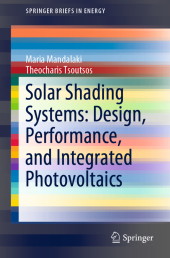 Neuerscheinungen 2019Stand: 2020-02-01 |
Schnellsuche
ISBN/Stichwort/Autor
|
Herderstraße 10
10625 Berlin
Tel.: 030 315 714 16
Fax 030 315 714 14
info@buchspektrum.de |

Maria Mandalaki, Theocharis Tsoutsos
(Beteiligte)
Solar Shading Systems: Design, Performance, and Integrated Photovoltaics
1st ed. 2019. 2019. vii, 128 S. 26 SW-Abb., 40 Farbabb., 25 Farbtabellen. 235 mm
Verlag/Jahr: SPRINGER, BERLIN; SPRINGER INTERNATIONAL PUBLISHING 2019
ISBN: 3-03-011616-6 (3030116166)
Neue ISBN: 978-3-03-011616-3 (9783030116163)
Preis und Lieferzeit: Bitte klicken
This is the first book to describe the development of and state of the art in solar shading devices in buildings, detailing all methods of evaluating shading systems according to thermal and visual comfort.
The issue of energy balance in buildings is gaining importance as conventional energy sources dwindle and become more expensive. As such, environmental concerns should be considered in overall design decisions.
The book discusses the role sun control "machines" play in controlling solar and thermal radiation. It examines their geometry, their position in relation to glazing and their operation (in the cases of movable systems) to control the heat and light entering a building, as well as how their material and color influence their performance.
This book appeals to architects and designers who are interested in efficient energy facade design.
1. Basics of Shading Design, the evolution of shading through time and the methods of evaluating appropriate shading systems according to simple geometrical rules.- 2. Geometrical and material properties of the shading system in relation to thermal gains.- 3. Basics of shading design in relation to both daylight quality and energy savings, through decreasing the amount of electric light needed.- More specific requirements for the case of office buildings, is presented.- 4. Additional parameters of energy production that shading systems with integrated PV can support is presented. Limitations and constrains of the integration of PV influencing the final performance of the devices and the aesthetics of the building.- 5. Discussion and conclusion.


